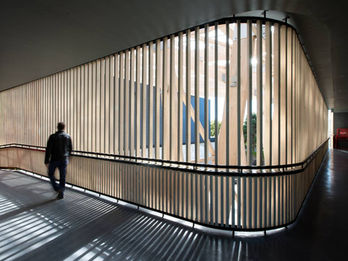2018 Americas Prize

Arauco Cultural Center
Mirene Elton and Mauricio Leniz
Aracuo, Chile
September 2016
PRIMARY AUTHOR
Mirene Elton Mauricio Léniz
CONTRIBUTING AUTHOR
Nicolás Jure (Collaborating Architect) Felipe Giannini (Collaborating architect) Sebastián Laclabere (Collaborating architect) Daniela Muñoz (Collaborating architect) Katerina Jofré (Lighting design) Hugo Grisanti (Interior design) Kana Cussen (Interior design) Raul López Cauly (Scenography) Manuel José Ruiz (Structural engineering) Francisco Tirapeguy (Main contractor)
CLIENT
Claudio Aravena Gatica
PHOTOGRAPHER
Felipe Díaz Contardo
OBJECTIVE
The building was conceived as a public meeting place, which allows it to develop all kinds of cultural and artistic events. On this premise three projective strategies were proposed: 1. - Public and private space, understanding the sense of use. The first floor will be understood as absence of built mass and the second floor as built mass, allowing the street-level architectural program to shelter; the theater, the cafeteria, the store, the exhibition foyer and multipurpose rooms, all related to its connection to the urban public street. The decision to suspend the slightly more private program of offices and library, obeys to protect the people and building against natural disasters such as the tsunami that hit the city in 2010. 2. The library, administration and services are located on the second level, quiet and restrained. The library covers almost the entire perimeter of this level and configures both sides of the urban corner. The horizontal window, which cuts the facade along its entire facade allowing the entry of light and its protection with the use of laminated wood brise-soleils that filter the western sun directing the view towards Colo Colo Hill, a sacred place for the Mapuche people. The second floor extends over the sidewalk, allowing pass through the interior of the building giving it lightness as an urban invitation to pedestrian. 3. The layout of the volumes forms a central space that we call Plaza that acts as a foyer, it is roofed to be used all year round.
CONTEXT
It is a very small city, with very little public infrastructure and that lives mainly on timber production. Citizens must go to the city of Concepción in terms of health, education and culture. The 2010 earthquake destroyed part of the country and Arauco, with buildings such as the library, and the municipal theater. This event, together with the reconstruction, brought together the public and private sector, the company Arauco, the municipality and the community, to develop new infrastructure to replace and substantially improve la destroyed buildings and deliver a better quality of urban cultural life in terms of the pedestrian use of the city together with the use of public space inside the block, a situation that did not exist in the city and that places value on the understanding of the city as heritage of its inhabitants. Another key aspect in the decision making of the project was the location of the building on the corner of the main avenue, articulating the pedestrian route between the civic square, the cultural center and the main beach of the city, recognizing the connectivity of the plot urban and its territory. This allows to generate identity and with it appropriation of the public space generating a civic attitude.
PERFORMANCE
The city of Arauco is located 570 kilometers south from Santiago, capital of Chile, right in the center of the country. It has a population that borders 35,000 inhabitants and rainfall that exceeds 40 inches per year. People in here are considered introverted and as a result of the climate and distance they develop their lives in a familiar way inside their homes without publicly using the city as a result of the continuous rains. The sense of the project seeks that people leave their homes and manifest themselves in all the sense of their cultural roots. In this way the city begins to have a use because of what the building offers with its billboard of activities such as; theater, cinema, dance, meeting spaces and a new public library to promote the study of children, who in most cases do not have adequate space in their homes. In small cities, the municipality is responsible for providing support to its citizens and the Arauco cultural center allows people not to travel outside the city to have the opportunity to enjoy shows, saving money, time, but more importantly , validating its city as a center of cultural activity. The fact of being a building conceived in its essence as a public space, breaks with the borders of ignorance and discrimination when it says: "everyone is invited".











